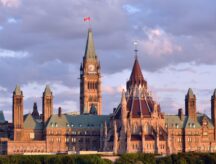New immigrants made up 61% of Canada’s population growth in 2018
A new Statistics Canada report reveals how immigration to Canada continues to be the main driver of population growth, with a total increase of 321,065 new immigrants in 2018.
By the start of 2019, Canada’s population reached 37,314,442, following a record increase of new immigrants in the fourth quarter of 2018.
Over the course of 2018, Canada’s population grew by over half a million, or 528,421 people. International migration accounted for 80.5 per cent of the growth, representing a combined total of 425,245 new immigrants and temporary residents to the country.
Temporary residents in Canada are individuals who have been legally granted the right to live in Canada on a temporary basis on either a visit, work, student permit or any other temporary status granted by Immigration, Refugees and Citizenship Canada (IRCC).
The reported immigration numbers surpass natural growth numbers (births minus deaths) for the year, which is recorded at 103,176.
The Statistics Canada report indicates that the population growth bump is unusual for a fourth quarter of a year, as this is typically when population growth slows down due to seasonal patterns.
The graph above shows that international migration has been a major driver of population growth. This could be due to Government of Canada initiatives that were introduced in recent years to improve its now widely-acclaimed immigration system.
In 2015, the Government of Canada introduced its Express Entry selection system.
Through Express Entry, the federal government selects candidates who meet the country’s labour market needs and invites them to apply for Canadian permanent residence. The system is designed to facilitate the processing of applications for Canada’s three main economic immigration program — the Federal Skilled Worker Class, Federal Skilled Trades Class and Canadian Experience Class while maintaining the processing time to less than six months.
Canada issued a record-breaking 89,800 Invitations to Apply (ITAs) for Canadian permanent residence to eligible candidates through the Express Entry system in 2018.
Find out if you are eligible to enter the Express Entry pool
In the fourth quarter of 2018, IRCC released its three-year immigration levels plan for 2019 to 2021.
Economic immigration is a central component of that plan, which has an admissions target of 330,800 new permanent residents for this year.
This number grows annually and is set at 350,000 by 2021 — nearly one per cent of Canada’s population.
By increasing Canada’s immigration rate, the country aims to attract and retain overseas talent to support labour market shortages across the country.
Another important feature of the three-year immigration levels plan is Canada’s Provincial Nominee Program (PNP), which has a target that is set to rise from 61,000 new admissions in 2019 to 71,300 new admissions in 2021.
Introduced in 1998, the PNP allows participating Canadian provinces and territories to nominate a set number of eligible candidates for Canadian permanent residence each year in order to meet their local labour market needs.
In reference to the three-year immigration level’s plan, Canada’s immigration minister, Ahmed Hussen, said:
We have developed our levels plan in close consultation with provinces and territories, allowing them to bring in more people through their Provincial Nominee Programs [PNPs].
We have also addressed regional needs by implementing the Atlantic Immigration Pilot and supporting francophone immigration communities outside Quebec.”
Statistics Canada quarterly data also show that in 9 out of 10 Canadian provinces international migration was the main driver behind population growth over natural and interprovincial increases in the fourth quarter of 2018.
“It is evident that the Canadian government is taking measures to attract and retain the best and the brightest to the country. It is also important to note the role that immigration plays in growing Canada’s population and populating various regions across our beautiful and vast country,” says Attorney David Cohen at the Campbell Cohen Law Firm in Montreal.
© 2019 CICNews All Rights Reserved
- Do you need Canadian immigration assistance? Contact the Contact Cohen Immigration Law firm by completing our form
- Send us your feedback or your non-legal assistance questions by emailing us at media@canadavisa.com



